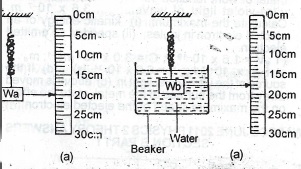(a) Explain diffusion.
(b) Give one reason why the rate of diffusion is higher in gases than in liquids at the same temperature.
State: (a) the difference between plane polarized light and ordinary light;
(b) two uses of polaroids.
(a). State: (a) two applications of electrolysis in an industry
(b) one application of electrolysis in a school laboratory.

In fig. la and fig.1 b above, Ida and Wb represent the respective loads on a spring placedtiear a 30 cm rule, when in air and when in water:
(a) Identify the force causing a shrink in the spring in fig.(b).
(b) Given that the force constant of the spring is 2.0 x 10\(^{11}\) Nm\(^{-1}\), calculate the work done by the force in causing the shrink.
Explain why water in a narrow glass tube has a concave meniscus while mercury, in the same tube, has a convex meniscus.